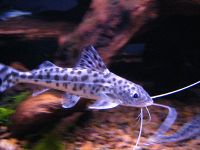Spotted Pimelodus (Pimelodus pictus)
From The Aquarium Wiki
Revision as of 01:10, 31 March 2015 by HalfbeakedGar (talk | contribs)
Spotted Pimelodus
Pimelodus pictus
208 Litres (55 US G.)
11.9-27.7cm (4.7-10.9 ")
Freshwater
5.8 - 7.0
21.7-25°C (71 -77 °F)
5-12 °d
1:2 M:F
8-10 years
Family
Pimelodidae
Contents
Additional names
- Pictus, Pimpictus, Spotted Pimelodus, Pim Pictus
Additional scientific names
- Pimelodella picta, Pimelodella pictus
Origin
- Found in the Peruvian and Columbian Amazon.
Sexing
- It is not possible to sex this fish.
Tank compatibility
- Peaceful catfish, can eat smaller fish or fry, but otherwise will not bother tank mates. Keep with other peaceful larger active fish and nothing that can nip barbels. If there are hiding places (caves, driftwood), this catfish will become territorial and chase any fish that swims by. During feeding time, the Pictus Catfish will come out of hiding and not bother others until food is gone.
Diet
- An unfussy omnivore. Most prepared foods are taken and the fish will gorge itself on live or frozen foods to a point where the aquarist must be careful not to feed too much in one sitting. Bloodworm induces a feeding frenzy and is good for acclimatizing new acquisitions.
Feeding regime
- Feed once a day in small amounts if possible. The fish will eat huge amounts in one day, its belly swelling to resemble a marble. It can happily live off this for up to a day or two, then will ask for more.
Environment Specifics
- Swimming space is needed as this fish likes to swim especially around feeding time. You will see much more of this fish during the day if you have relatively dim lighting. 15 gallon fish tanks will be fine for these fish at young age, like the age of when you get them at the Pet Store. But as they mature to full-size, 55 gallons is needed then. But they rarely get to 10 inches, only if they've been well-maintained their whole life. They usually get 4-8 inches in captivity.
Behaviour
- A larger active fish that is generally peaceful. Just avoid fish small enough to fit in this fish's mouth. Also avoid fish that will nip at its barbels, or fish that will eat this fish, because the fish will choke on the venomous barbels of this fish, and possibly die.
Identification
- An elongate fish with a forked caudal fin and several long barbels around the mouth. It is silver-grey in base colour with many darker spots on the body. There are two colour forms seen. The Peruvian has dalmatian-like spots which are larger on the body and smaller around the head. The Columbian has much smaller less defined spots.
Pictures
External links
- Fishbase (Mirrors: Error creating thumbnail: Unable to save thumbnail to destination)
